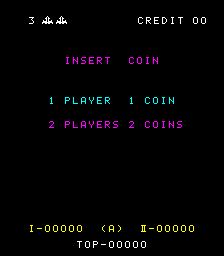If you appreciate the work done within the wiki, please consider supporting The Cutting Room Floor on Patreon. Thanks for all your support!
Space Fever
Jump to navigation
Jump to search
Cleanup > Pages missing date references
Cleanup > Pages missing developer references
Cleanup > Pages missing publisher references
Games > Games by content > Games with revisional differences
Games > Games by developer > Games developed by Nintendo > Games developed by Nintendo EPD > Games developed by Nintendo SPD > Games developed by Nintendo R&D1
Games > Games by platform > Arcade games
Games > Games by publisher > Games published by Nintendo
Games > Games by release date > Games released in 1979
Games > Games by release date > Games released in June
| Space Fever |
|---|
|
Developer: Nintendo R&D1
|
Space Fever is another Space Invaders clone, but at least they were nice enough to put in three different modes of play.
Revision Differences
There are three different versions in the MAME romset: spacefev (New), spacefevo (Older), and spacefevo2 (Oldest).
Gameplay Changes
- The game changes the fire delay of the invaders based on the player's score. The delay decreases when the player's score is greater or equal to 300, 1100, 2100, 3100:
| Default | 300 | 1100 | 2100 | 3100 |
|---|---|---|---|---|
| 56 frames | 16 frames | 11 frames | 8 frames | 6 frames |
- In the new version, the highest point threshold is changed to 5100 points.
- The delay changes again after the player has at least 10,000 points. In the oldest version, the game will just stop checking the score, but since the delay has to be rechecked and set every frame, what ends up happening is that the delay changes from 6 frames to the default 56 frames.
- In the other versions, once the player has at least 10,000 points, the delay is set to 4 frames.
- The method the games uses to calculate the UFO bonus is different in the oldest version. In that version, RAM address 608D is a pointer to a UFO bonus table. That RAM address is incremented every time one of the player's shots hits something, which includes the shields at the bottom and the top of the screen. The pointer always starts at 18C8.
- Note that this is the same basic method that Space Invaders used, and a lot of values in the tables are the same:
| Space Invaders | 100 | 50 | 50 | 100 | 150 | 100 | 100 | 50 | 300 | 100 | 100 | 100 | 50 | 150 | 100 | 50 |
|---|---|---|---|---|---|---|---|---|---|---|---|---|---|---|---|---|
| Space Fever | 150 | 300 | 50 | 100 | 150 | 100 | 100 | 150 | 300 | 50 | 100 | 150 | 50 | 150 | 100 | 300 |
- In other versions, the UFO bonus is determined by the value of universal game timer (60C0) at the time the UFO was hit, modulo 4:
| 0 | 1 | 2 | 3 |
|---|---|---|---|
| 50 | 100 | 150 | 300 |
Visual Changes
| Old | New |
|---|---|
The "TOP" score text is 8 pixels lower in spacefev and spacefevo.
| Old | New |
|---|---|
In the oldest version, the explosion animation has two frames, but they're identical. The other versions fix this by changing the second frame.
(Source: Original TCRF research)
Cleanup > Pages missing date references
Cleanup > Pages missing developer references
Cleanup > Pages missing publisher references
Games > Games by content > Games with revisional differences
Games > Games by developer > Games developed by Nintendo > Games developed by Nintendo EPD > Games developed by Nintendo SPD > Games developed by Nintendo R&D1
Games > Games by platform > Arcade games
Games > Games by publisher > Games published by Nintendo
Games > Games by release date > Games released in 1979
Games > Games by release date > Games released in June
